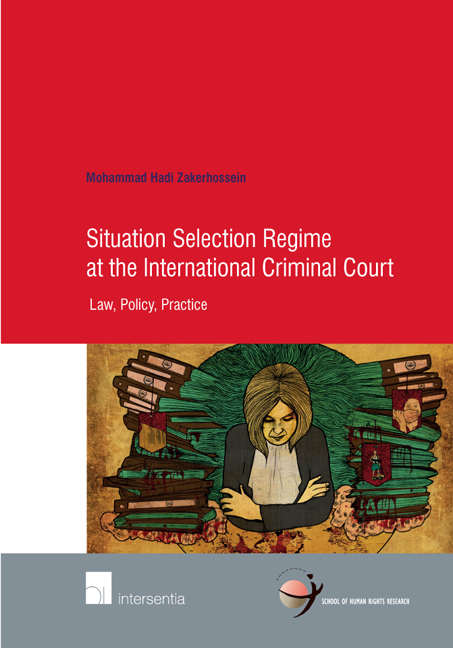Book contents
- Frontmatter
- Contents
- Acknowledgment
- Abbreviations
- General Introduction
- Part One Formulating the Concept of Situation in the Rome Statute Sense
- Part two Situation Selection Process
- Chapter I Trigger Mechanism
- Chapter II Identification Stage
- Chapter III Preliminary Examination
- Chapter IV Making a Decision on the Situation Selection
- Part three Situation Selection Criteria
- Part Four Situation Selection In Light Of Expressivism
- Conclusion
- Bibliography
- ICC Case Tables
- OTP Documents
- About the Author
- School of Human Rights Research Series
Chapter IV - Making a Decision on the Situation Selection
from Part two - Situation Selection Process
Published online by Cambridge University Press: 13 October 2018
- Frontmatter
- Contents
- Acknowledgment
- Abbreviations
- General Introduction
- Part One Formulating the Concept of Situation in the Rome Statute Sense
- Part two Situation Selection Process
- Chapter I Trigger Mechanism
- Chapter II Identification Stage
- Chapter III Preliminary Examination
- Chapter IV Making a Decision on the Situation Selection
- Part three Situation Selection Criteria
- Part Four Situation Selection In Light Of Expressivism
- Conclusion
- Bibliography
- ICC Case Tables
- OTP Documents
- About the Author
- School of Human Rights Research Series
Summary
The final stage in the situation selection process is making a decision by the Prosecutor. Preliminary examination as an evaluation process produces an output, namely the prosecutorial decision to or not to initiate an investigation into a situation undergone the process. This finding marks a new phase at the ICC's architecture in which the judges of the Court may exercise a supervisory role over the Prosecutor's discretion. Hence, this phase is important from an institutional and internal perspective.
The Prosecutor, upon conducting a preliminary examination, may arrive at two different conclusions. She may believe that there is a reasonable basis to open an investigation or, by contrast, she may believe the lack thereof. The former furthers a situation into the case phase, whereas the latter puts an end to a situation examination. However, the preliminary examination's findings are preliminary in nature. It means that, as Article 53(4) provides, “the Prosecutor may, at any time, reconsider a decision whether to initiate an investigation or prosecution based on new facts and information.”
The present chapter aims at offering some insight into the latest step that is taken in the situation selection process, namely making a determination whether or not to proceed with a situation by conducting an investigation.
OPENING AN INVESTIGATION
Preliminary examination is a filtering mechanism to opt for a proper situation for investigation. If the Prosecutor finds that there is a reasonable basis to believe that a situation meets the statutory criteria to initiate an investigation, then she proceeds with the situation. However, the way ahead of the Prosecutor that should be followed to reach the investigation phase is different in terms of the trigger that brings a situation to the Prosecutor's attention. The ICC trigger mechanism produces two products, namely referrals and communications. Referrals are made by States Parties or the UNSC. On the contrary, communications are predominantly made by non-State actors, including NGOs and individuals. As to referrals, if the Prosecutor determines that the statutory requirements to select a situation are met, she initiates an investigation without any need to get extra permission from the Court's judges, whereas the decision of the Prosecutor to open an investigation into a situation communicated to her under Article 15 needs judicial approval.
- Type
- Chapter
- Information
- Situation Selection Regime at the International Criminal CourtLaw, Policy, Practice, pp. 131 - 160Publisher: IntersentiaPrint publication year: 2017



